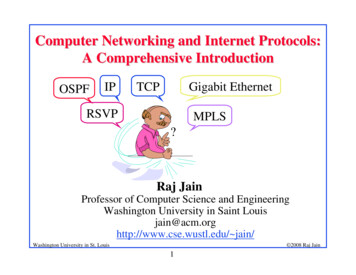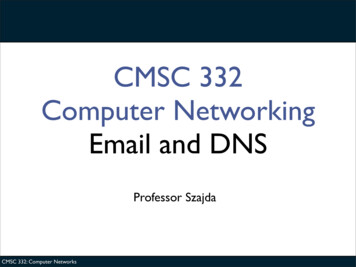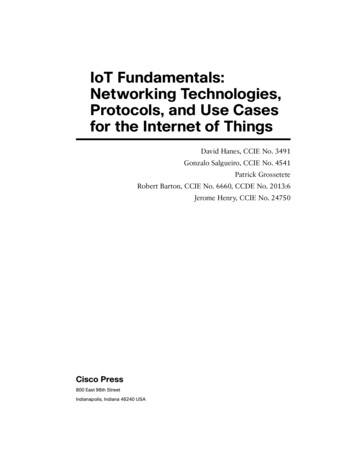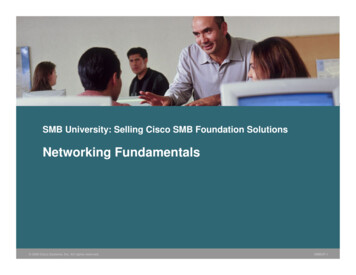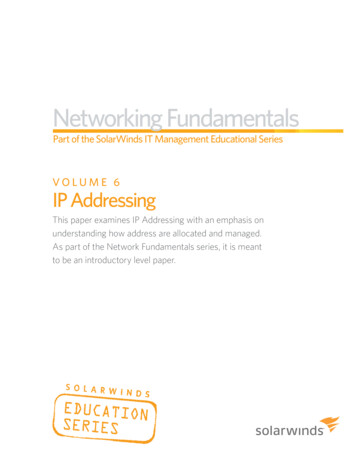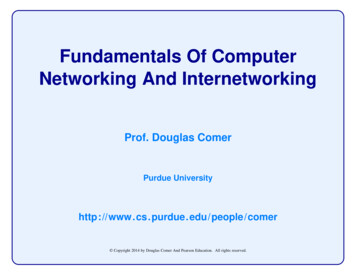
Transcription
Fundamentals Of ComputerNetworking And InternetworkingProf. Douglas ComerPurdue Universityhttp://www.cs.purdue.edu/people/comer Copyright 2014 by Douglas Comer And Pearson Education. All rights reserved.
MODULE IIntroductions, Course Overview,Approaches To Networking, Open AndClosed Systems, Protocols, And LayeringComputer Networks and Internets -- Module 11Copyright 2014. All rights reserved.Spring, 2014
Introductionsd Professord TAsd StudentsComputer Networks and Internets -- Module 12Copyright 2014. All rights reserved.Spring, 2014
CourseOverview
Topic And ScopeComputer networks and internets: an overview of concepts,terminology, and technologies that form the basis for digitalcommunication in individual networks and the global InternetComputer Networks and Internets -- Module 14Copyright 2014. All rights reserved.Spring, 2014
You Will Learnd Fundamental principlesd Conceptsd Terminology (lots of it)d Key aspects of networkingComputer Networks and Internets -- Module 15Copyright 2014. All rights reserved.Spring, 2014
The Five Key Aspects Of Networkingd Data communications: signals over wires and bits oversignalsd Networks: packets over bitsd Internets: datagrams over packetsd Network programming: application data over the Internetd Cross-functional concepts and technologies: networkconfiguration, control, and managementComputer Networks and Internets -- Module 16Copyright 2014. All rights reserved.Spring, 2014
Features Of The Coursed Covers all of networking and internetworking from media toapplicationsd Examines each of the underlying technologiesd Focuses on concepts and principles that apply acrossvendors and productsd Provides perspective and shows how the pieces fit togetherd Explains how an Internet is built from heterogeneousnetworksComputer Networks and Internets -- Module 17Copyright 2014. All rights reserved.Spring, 2014
What You Will Not Learnd Commercial aspects–Vendors–Products–Prices–Markets and marketingd How to engineer network equipmentd How to configure/operate networksd How to design new protocolsComputer Networks and Internets -- Module 18Copyright 2014. All rights reserved.Spring, 2014
Practice Sessions (Aka Labs)d Form an important part of the coursed You will–Build network programs–Capture and analyze packets–Learn about protocolsComputer Networks and Internets -- Module 19Copyright 2014. All rights reserved.Spring, 2014
Background Expectedd Our goal is breadth rather than depthd Only a few basics are needed–Ability to program in C–A glancing acquaintance with data structures andpointers–A minor brush with algebra–A basic understanding of operating systemsd The major requirement is a desire to learnComputer Networks and Internets -- Module 110Copyright 2014. All rights reserved.Spring, 2014
Summary Of The Coursed Explores all aspects of networking and internetworkingd Gives concepts and principlesd Focuses on the big pictured Includes lots of programming exercisesd Moves rapidly and covers lots of vocabularyComputer Networks and Internets -- Module 111Copyright 2014. All rights reserved.Spring, 2014
Questions?
Historic ApproachesTo Networking
How Should A Network Be Structured?Computer Networks and Internets -- Module 114Copyright 2014. All rights reserved.Spring, 2014
How Should A Network Be Structured?d The early phone company answer–Data networking is like telephone calls–We will devise and offer various data services–Charges will depend on distance and duration–You only need 128 KbpsComputer Networks and Internets -- Module 114Copyright 2014. All rights reserved.Spring, 2014
How Should A Network Be Structured?d The early phone company answer–Data networking is like telephone calls–We will devise and offer various data services–Charges will depend on distance and duration–You only need 128 Kbpsd The early computer vendor answer–A network connects computers in your organization–We will devise all the necessary equipment and software–You only need to connect our computers–You only need to run our applicationsComputer Networks and Internets -- Module 114Copyright 2014. All rights reserved.Spring, 2014
How Should A Network Be Structured?(continued)d The early network equipment vendor answer–The network is independent of computers–We will create network equipment and interfacehardware that connects computers to our network–We will build device drivers for your operating system–You only need to use our networkComputer Networks and Internets -- Module 115Copyright 2014. All rights reserved.Spring, 2014
Some Resulting Commercial Network Systemsd Apple Computer Appletalkd Banyan Vinesd Digital Equipment Corporation DECNETd IBM SNAd Novell Netwared Ungermann Bass NET/ Oned Xerox XNSComputer Networks and Internets -- Module 116Copyright 2014. All rights reserved.Spring, 2014
The Researcher’s Answerd Although we have computers at multiple sites, we reject thephone company’s approachd Because we use diverse computer architectures, we rejectthe computer vendors’ approachd Because a variety of network technologies are possible, wereject the network vendors’ approachd A variety of applications are possibled Let’s experiment with new technologies (short distance aswell as long distance) and new applicationsComputer Networks and Internets -- Module 117Copyright 2014. All rights reserved.Spring, 2014
Some Resulting Research Projectsd Xerox Palo Alto Research Center–Ethernetd MIT and elsewhere–Token passing ring networksd Department of Defense–ARPANET–SATNET–Packet radio net–The global InternetComputer Networks and Internets -- Module 118Copyright 2014. All rights reserved.Spring, 2014
Open Vs. Closed Networkingd Closed networks–Vertical approach–Each vendor designs/ builds their own–Given technology owned by vendor–Vendor may license technology to other groupsd Open networks–Competitive approach–Multiple groups collaborate to define a technology–To insure interoperability, specifications written instandards documents that are available to everyone–Companies build products according to standardsComputer Networks and Internets -- Module 119Copyright 2014. All rights reserved.Spring, 2014
Questions?
Protocol StandardsAnd Protocol Design
Why Standardize?d Networking supports communication among multipleentitiesd Agreement needed to make communication correct, efficient,and meaningfulComputer Networks and Internets -- Module 122Copyright 2014. All rights reserved.Spring, 2014
Which Organizations Issue Standards?d IEEE (Institute of Electrical and Electronics Engineers)d IETF (Internet Engineering Task Force)d ITU (International Telecommunications Union)d ISO (International Organization for Standardization)d W3C (World Wide Web Consortium)d .and many othersComputer Networks and Internets -- Module 123Copyright 2014. All rights reserved.Spring, 2014
Standards And Standardizationd Joke: why is networking so difficult?Computer Networks and Internets -- Module 124Copyright 2014. All rights reserved.Spring, 2014
Standards And Standardizationd Joke: why is networking so difficult?d Because there are so many standards from which to chooseComputer Networks and Internets -- Module 124Copyright 2014. All rights reserved.Spring, 2014
Protocold Each protocol specifies how to handle one aspect ofcommunicationd A protocol can specify–Low-level details such as voltage and frequency–High-level details such as format visible to a userd Many individual communication protocol standards existd Set of protocols designed to work together is known as asuite–Example: TCP/ IP Internet protocol suiteComputer Networks and Internets -- Module 125Copyright 2014. All rights reserved.Spring, 2014
Two Key Properties That Protocols Specifyd Syntax–Format of each message–Representation of data items–Encoding of bits in electromagnetic signalsd Semantics–Meaning of each message–Procedures used to exchange messages–Actions to take when an error occursComputer Networks and Internets -- Module 126Copyright 2014. All rights reserved.Spring, 2014
Steps In Protocol Designd Look at the facilities the underlying hardware providesComputer Networks and Internets -- Module 127Copyright 2014. All rights reserved.Spring, 2014
Steps In Protocol Designd Look at the facilities the underlying hardware providesd Imagine an abstract communication mechanism as a userwould like it to workComputer Networks and Internets -- Module 127Copyright 2014. All rights reserved.Spring, 2014
Steps In Protocol Designd Look at the facilities the underlying hardware providesd Imagine an abstract communication mechanism as a userwould like it to workd Design an efficient implementation of the abstractionComputer Networks and Internets -- Module 127Copyright 2014. All rights reserved.Spring, 2014
Steps In Protocol Designd Look at the facilities the underlying hardware providesd Imagine an abstract communication mechanism as a userwould like it to workd Design an efficient implementation of the abstractiond The key to success: choose a good abstractionComputer Networks and Internets -- Module 127Copyright 2014. All rights reserved.Spring, 2014
Why Protocol Design Is Difficultd Multiple implementations of a protocol will existd Implementations will be created by a multipleindividuals/organizationsd There are many details to considerd Key tradeoff–A specification that dictates all possible details restrictsimplementations–A specification that does not specify enough details isambiguous and leads to incompatible implementationsComputer Networks and Internets -- Module 128Copyright 2014. All rights reserved.Spring, 2014
Maximizing Interoperabilityd Design principle that maximizes interoperability (due toPostel)Be conservative in what you sendand be liberal in what you accept.Computer Networks and Internets -- Module 129Copyright 2014. All rights reserved.Spring, 2014
Protocol Layeringand Layering Models
Protocol Layeringd Needed because communication is complexd Intended primarily for protocol designersd Divides communication into intellectually manageablepiecesd Provides a conceptual framework that can help usunderstand protocolsd Ideally, layering is invisible once protocols have beendesignedd Notes:–Layering gives a guideline, not a rigid framework–Optimizations may violate strict layeringComputer Networks and Internets -- Module 131Copyright 2014. All rights reserved.Spring, 2014
Two Layering Modelsd Internet protocols use a 5-layer reference modeld ISO and the ITU defined a 7-layer modelComputer Networks and Internets -- Module 132Copyright 2014. All rights reserved.Spring, 2014
Two Layering Modelsd Internet protocols use a 5-layer reference modeld ISO and the ITU defined a 7-layer modelComputer Networks and Internets -- Module 132Copyright 2014. All rights reserved.Spring, 2014
Internet Reference ModelApplicationLAYER 5TransportLAYER 4InternetLAYER 3Network InterfaceLAYER 2PhysicalLAYER 1d Descriptive model formed after TCP/IP protocols weredevisedd Used in practiceComputer Networks and Internets -- Module 133Copyright 2014. All rights reserved.Spring, 2014
Physical Layerd Underlying transmission mediad Electromagnetic energy and its used Representation of information in signalsd Electrical properties such as radio frequencies and voltaged Associated hardwareComputer Networks and Internets -- Module 134Copyright 2014. All rights reserved.Spring, 2014
Network Interface Layerd Communication between a computer and network hardwared Also called data link or MAC layerd Mechanisms for gaining access to shared mediad Hardware (MAC) addressingd Packet (frame) formatsd Packet (frame) types and demultiplexingd Error detectionComputer Networks and Internets -- Module 135Copyright 2014. All rights reserved.Spring, 2014
Internet Layerd Communication between a pair of computers across theInternetd Internet packet format (datagram)d Internet addressing model and address assignmentd Forwarding of Internet packetsd Dividing an Internet packet into smaller packets fortransmissiond Error detection and reportingComputer Networks and Internets -- Module 136Copyright 2014. All rights reserved.Spring, 2014
Transport Layerd Communication between a pair of applicationsd Demultiplexing among multiple destinations on a computerd Reliable delivery and retransmissiond Mechanisms to control data rate and avoid congestionComputer Networks and Internets -- Module 137Copyright 2014. All rights reserved.Spring, 2014
Application Layerd Format and representation of data and messagesd Procedures applications follow to–Transfer data–Handle errors or unexpected conditionsd Meaning of messages exchangedd Internet infrastructure such as routing and DNSComputer Networks and Internets -- Module 138Copyright 2014. All rights reserved.Spring, 2014
General Idead Each computer contains an entire set of layered protocolsd When an application sends a message–The message passes down through the layered protocols–A given layer adds information and forms a packet–The computer transmits the final packetd When a packet arrives–The packet passes up through the protocol layers–A given layer performs processing and passes the packetup to the next layer–The application receives the message that was sentComputer Networks and Internets -- Module 139Copyright 2014. All rights reserved.Spring, 2014
Illustration Of Protocol Software On A ComputerApplicationComputer 1Computer 2ApplicationTransportTransportInternetInternetNet. InterfaceNet. InterfacePhysical Networkd Protocols on a computer arranged in a conceptual stackComputer Networks and Internets -- Module 140Copyright 2014. All rights reserved.Spring, 2014
Packet Headers As A Packet PassesAcross The Internetd One header prepended by each layer when message sentd Result: headers are nest
How Should A Network Be Structured? d The early phone company answer – Data networking is like telephone calls – We will devise and offer various data services – Charges will depend on distance and duration – You only need 128 Kbps d The early computer vendor answer – A network connects computers in your organization
